
Fireworks, firecrackers and loud, booming thunderstorms. Many people love these iconic summer events, but our pets often don’t. We recommend keeping your pets safely indoors during loud and dangerous summer events.
Fireworks and Thunderstorms
Fireworks, firecrackers, and loud, booming thunderstorms. Many people love these iconic summer events, but our pets often don’t. We recommend keeping your pets safely indoors during loud and dangerous summer events. Keeping your pets indoors will not only reduce the risk of them getting hurt during a storm, but it will also help prevent them from accidentally ingesting firework debris. Let them stay inside. Pets that are used to being outside should be brought indoors.

HELPING YOUR PET FIND RELIEF

A Google search for “products to help my dog with storm and noise anxiety” can lead you down a never-ending rabbit hole. From over-the-counter products and supplements, natural remedies, training and behavior modification, to suggestions for medications your veterinarian can prescribe, the options are endless and overwhelming. Spoiler alert: There is no one-size-fits-all solution for every pet. Your veterinarian can help you decide which direction to take based on your budget, personal preferences, or your pet’s specific needs. Below, we’ve included some of our top OTC picks (products available without a prescription) in addition to a few words about Rx’s available from your vet!
Disclaimer: always speak directly with your trusted veterinarian regarding any over-the-counter medications, products, and/or supplements you may be considering for your pet. Next to you, they know your pet best. Information found online (or from any other outside source) should never take precedence over the direct guidance and advice of your vet regarding your pet’s overall health.
OTC RELIEF
White Noise Machines
Some pet owners find it helpful to put their dogs in a crate, surround them with familiar toys, or put them in a quiet, isolated room. Turning on the TV or radio will help drown out outside noise and create what’s known as white noise. White noise has been shown to be effective in reducing the restlessness, agitation, and anxiety that a pet may experience as a result of these loud, booming sounds. Don’t have a TV or radio handy? No problem! There are a variety of white noise machines for every budget, in addition to white noise apps available on your phone*; all with the goal of providing relief, comfort, and peace of mind for your pet.
*standard rates and fees may apply


Photo by Isaac Davis on Unsplash
ThunderShirt®
A drug-free calming solution used by millions of dogs and cats worldwide is the ThunderShirt®. Recommended by veterinarians, the ThunderShirt® allows pets to feel calmer in stressful situations by applying gentle, constant pressure to calm all types of anxiety, fear, and over-excitement. Research on both humans and animals suggests that the pressure created by the ThunderShirt® may release a type of calming hormone similar to oxytocin or endorphins, which the makers of ThunderWorks® claim is helpful for over 80% of pets. Who can argue with that?
Check out the ThunderShirt® and other cool products ThunderWorks® has to offer by clicking here!
Feliway® and Adaptil®
Pheromones are natural messages that animals (including cats and dogs) use to communicate with the world around them. Feliway® is an over-the-counter product designed specifically for our feline friends, while Adaptil® is designed exclusively for dogs. Developed by Ceva Animal Health LLC, both products use pheromones to replicate the precise messages cats and dogs use to feel comfortable and secure in their environment, as well as the messages they use to live harmoniously with other animals. Feliway® and Adaptil® are both used and recommended by veterinarians worldwide.
For additional information and products available from Feliway® and Adaptil®, click the individual links below to be taken to their sites directly!
RX'S FROM THE VET

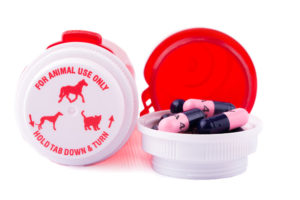
Medications and supplements prescribed directly by your veterinarian have been approved for direct or sometimes off-label use to benefit your individual pet’s circumstances, condition(s), and/or set of symptoms. Veterinarian-prescribed medications are backed by years (sometimes decades) of research, multiple clinical trials, and funding to bring them to market. In addition, they are approved for use in veterinary medicine and have been clinically proven to be safe in the vast majority of patients with minimal side effects. All side effects and outcomes are carefully reported, documented and published. When side effects are known, it is your trusted veterinarian who decides whether the benefits of the medication outweigh the risks – all for the health and well-being of your pet. Do your research. The use of any product and/or supplement given to your pet outside of the direction and recommendation of your veterinarian is at your own risk. Countless pets benefit from the use of veterinarian-prescribed medications to help them through stressful events large and small, short-term and lifelong. Talk to your veterinarian if you think your pet could benefit from prescription medication to treat anxiety and fear caused by a stressful event. It could be life-changing for both you and your pet!
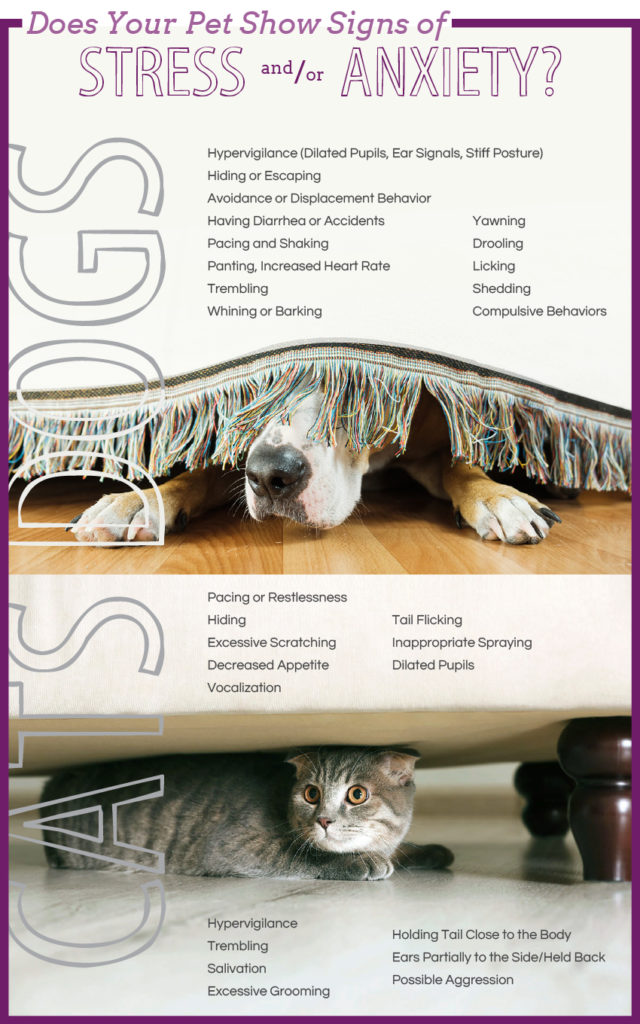
IMPORTANCE OF PET ID TAGS + MICROCHIPPING
We’ve heard of pets getting loose and running away from loud fireworks and, in some cases, thunderstorms. This can happen even if you’re trying to keep your pet inside. In some cases, a guest (or owner) may not realize that a door was left open or wasn’t closed properly, giving frightened pets a chance to escape. During a busy event with a house full of people, you may not notice that your pet isn’t where he or she should be. In fact, some of our clients have reported that their own pets have escaped through a window or broken through a screen door to escape the fear they feel during fireworks and thunderstorms.


It’s a good idea to make sure your pets are always wearing ID collars. We love it when clients take the extra precaution of having their pets microchipped (and making sure the chip is properly registered with up-to-date contact information). This way, if your pet does get lost, there is a better chance that he or she will be returned. Local shelters and animal control agencies rely on this information to help locate the owners of lost pets.
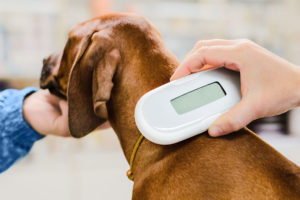
Traveling and Your Pet
Planning that summer road trip or flying across the country with Fido? In this section, we’ve covered the basics of traveling domestically with your pet during the summer, and what to do if you can’t bring Fido with you.
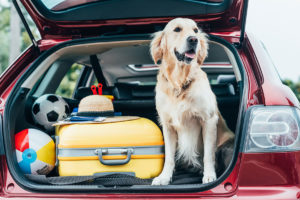
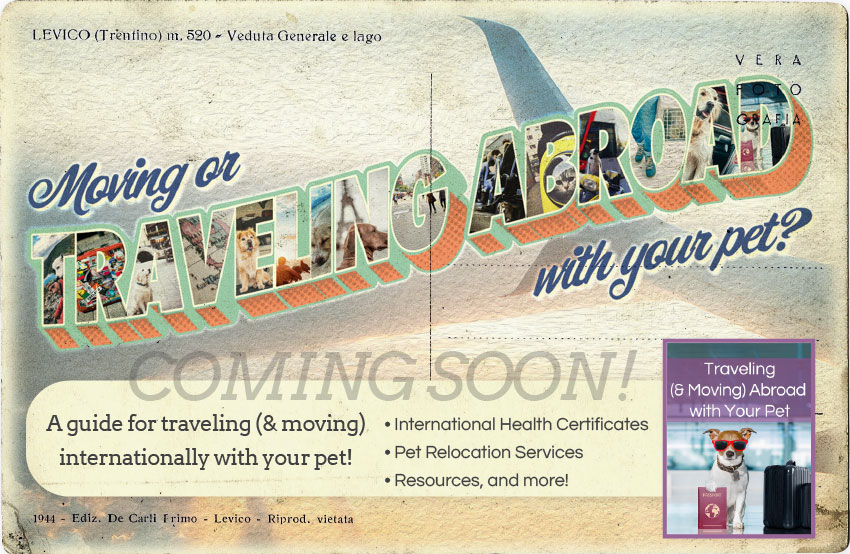
PLAN AHEAD & HEAD TO THE VET
Anytime you plan to travel with your pet, you need to plan ahead and be prepared. Thoughtful consideration of your pet’s safety and well-being is necessary for an overall successful trip.
To ensure a successful start for you and your furry friend, make an appointment with your veterinarian and let him or her know your plans. Your veterinarian will perform a thorough evaluation of your pet’s overall health, update any necessary vaccinations, and recommend any additional services, products, or treatments to ensure you and your pet are set up for success.
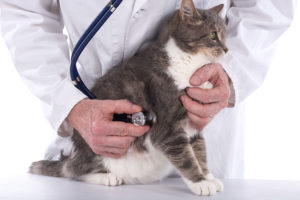
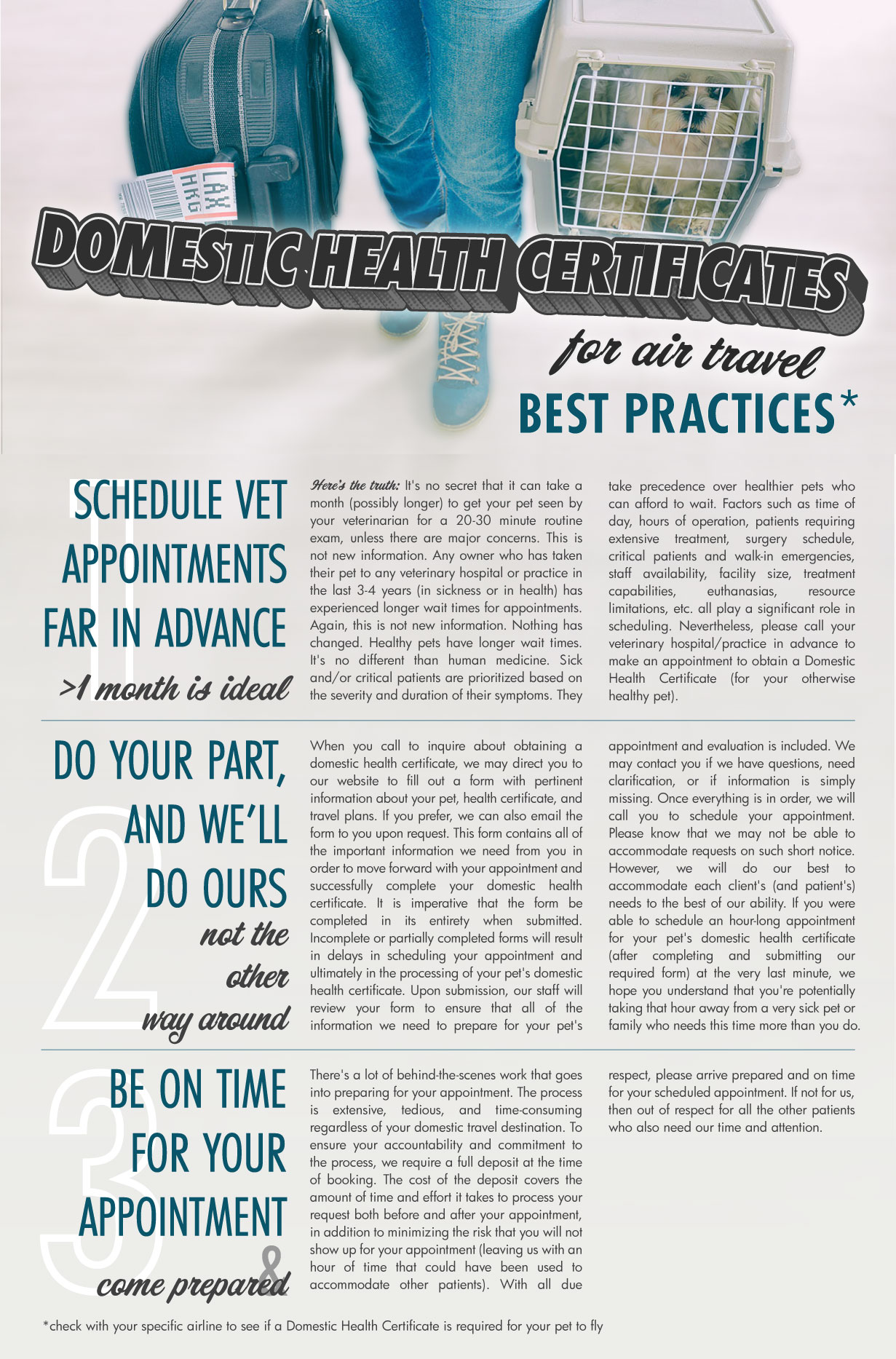
VACCINES, RABIES CERTIFICATES, AND APHIS (OH, MY!)
Vaccines should be updated (if necessary) when traveling outside your state of residence. Making sure your pet’s rabies vaccine is up to date is a priority. Be sure to get a few printed copies of your pet’s most recent (current) rabies certificate, signed by your veterinarian, and keep a copy with you at all times when you’re traveling. You never know when you might need it! If you plan to fly, check with your specific airline as they may require proof of rabies vaccination for your pet to fly (in addition to or in lieu of a domestic health certificate).

It is important to check if the state (or states) you are traveling to (or through) has specific entry requirements for pets, including (but not limited to) rabies vaccination by law. The Animal and Plant Health Inspection Service (APHIS), part of the U.S. Department of Agriculture (USDA), is an official government agency responsible for protecting the health and value of America’s agricultural and natural resources. This includes setting regulatory standards and requirements for animals imported into and exported from the United States. With regard to interstate pet travel, each state/territory has its own set of laws, regulatory standards, and requirements.
Check the APHIS website for individual state/territory requirements for traveling with your pet.
ACCOMODATIONS FOR AGING PETS WITH HEALTH CONCERNS

Traveling takes a toll on older pets, especially those with underlying health issues. Prolonged travel in a crate or confined space will be difficult for pets with arthritis and/or joint problems. Talk to your veterinarian about appropriate and reasonable accommodations to make travel more comfortable for your arthritic pet. Pets with known heart problems, such as congestive heart failure, may need special accommodations when they travel, especially by air. For this reason, your veterinarian may recommend that your furry friend stay grounded or not travel. Know that any recommendations your veterinarian makes regarding your pet’s health while traveling are made with your pet’s best interests in mind.

BRACHYCEPHALIC PETS
Due to their elongated soft palate, brachycephalic breeds (both cats and dogs) are more susceptible to respiratory problems, including cyanosis and respiratory distress. When traveling by air, it’s best to keep our brachycephalic friends out of the cargo hold. If your brachycephalic pet’s breed is on a specific “no fly” list, check with your airline to see if they will allow your pet to travel with you in the cabin (for an additional fee). For larger brachycephalic breeds (such as Bulldogs), check with your airline and veterinarian to determine alternative arrangements for traveling.
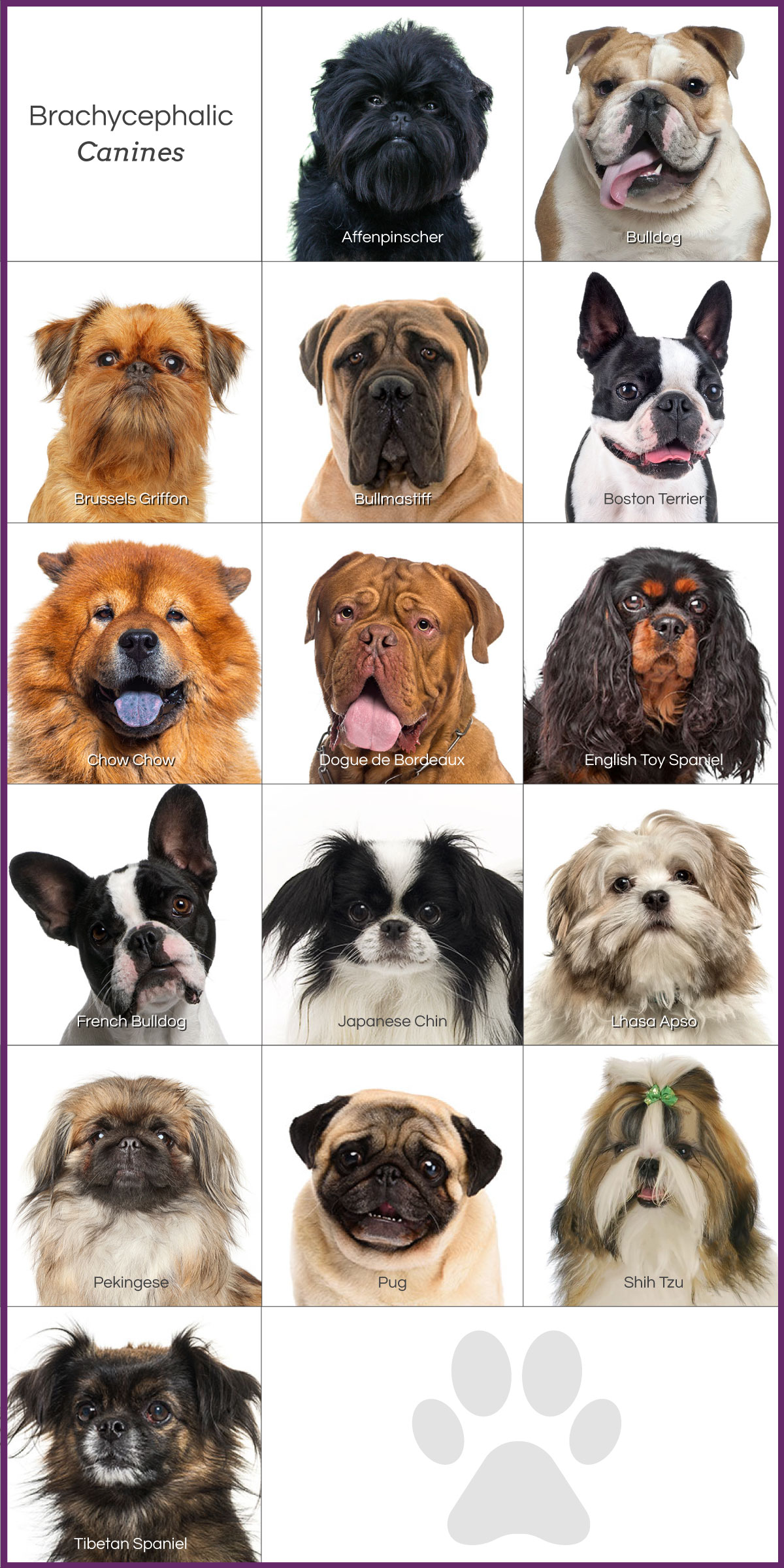
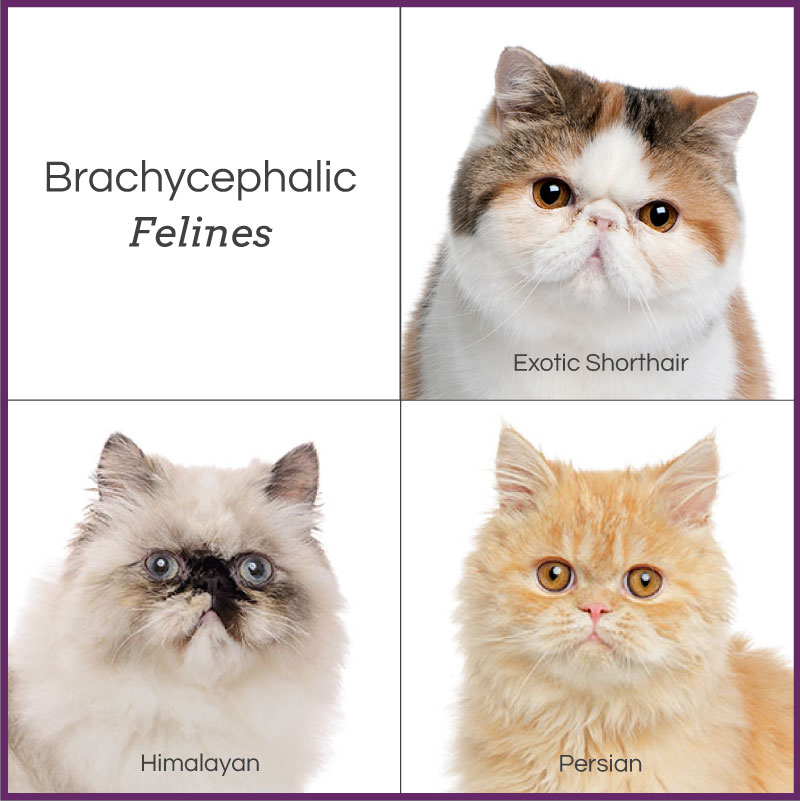
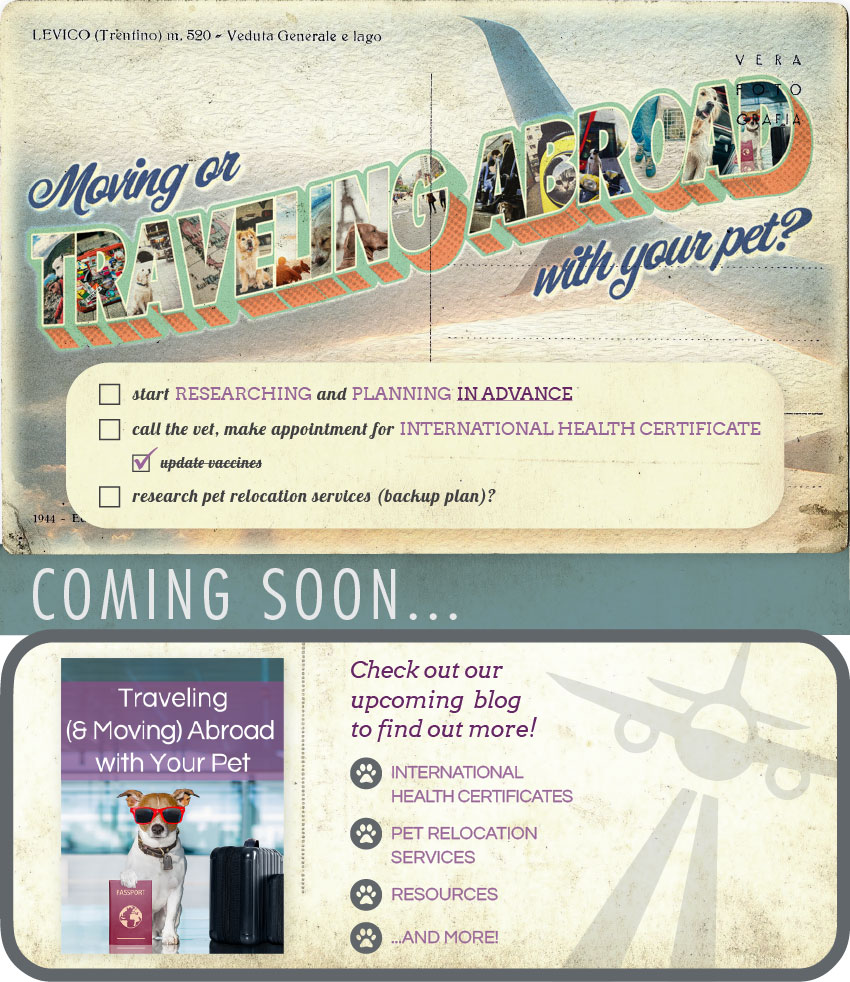
REFILL PET MEDICATIONS & PREVENTATIVES
Pet Medications
Pets take medications just like we do! Before you travel, make sure your pet has enough of his or her prescription medication(s) to last the duration of your trip. Request any refills well in advance of your departure in case your pet’s medication is out of stock and requires a special order from your veterinarian. If refills require a vet visit and routine blood work, even better!
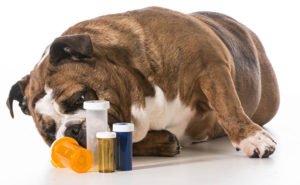
Preventatives
Internal parasites and external parasites. Both pose significant health risks to our pets and ourselves. For humans, practicing good hygiene and sanitation is enough to avoid contracting internal parasites. Our pets, however, depend on us to keep them healthy and parasite-free. The good news is that most parasites and parasitic diseases are avoidable with preparation and prevention. Two parasites of particular concern (see below) are why it’s a good idea to keep your pet on parasite prevention year-round (especially when traveling).
Heartworm
If you travel anywhere in the United States at any time of the year, you’re likely to encounter mosquitoes, putting your pet at increased risk for heartworm infection. There are at least 22 different species of heartworm-carrying mosquitoes in the United States, all of which are active at different times of the day and year. The southeastern United States has a particularly high incidence of heartworm-positive cases overall. Therefore, it’s important to take precautions when traveling to areas (in the southeastern United States or elsewhere) known to have a higher incidence of both mosquitoes and heartworm. The bottom line is to make sure your pet is on a year-round heartworm preventative. If you’re planning an extended trip, ask your veterinarian for refills (if needed) before you leave.
To learn more about heartworm disease, visit the American Heartworm Society.
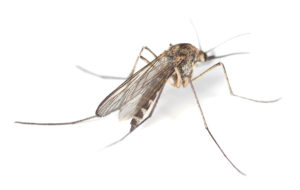
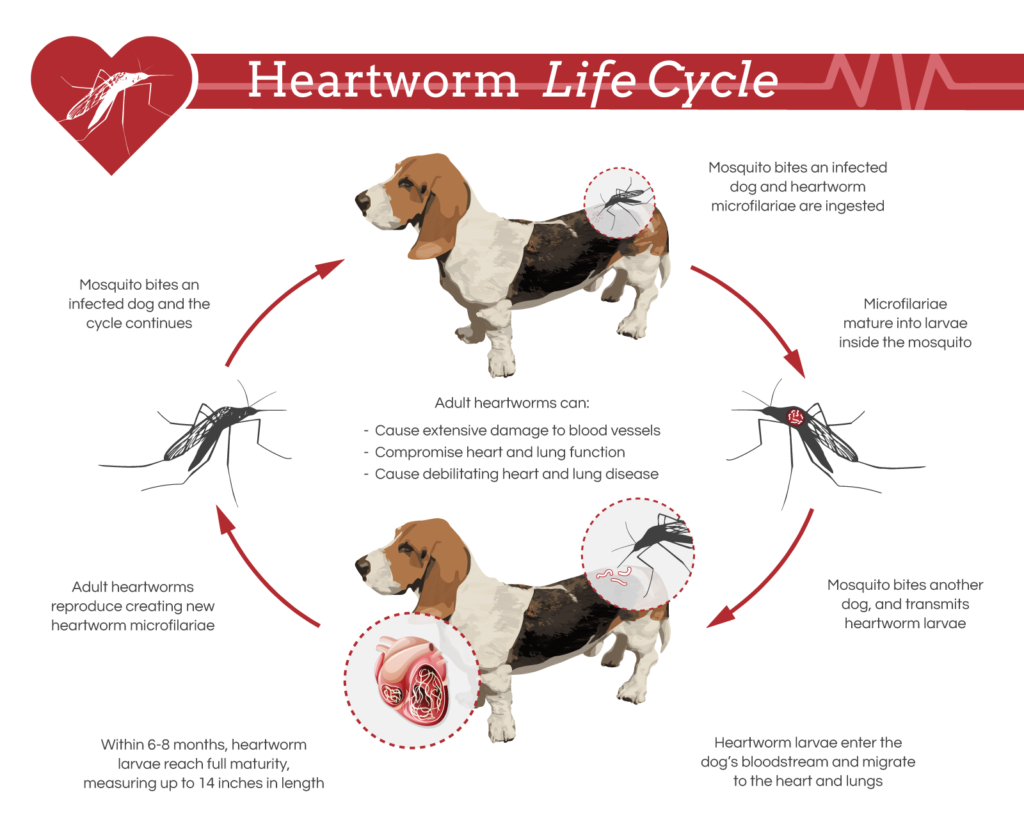
Tick
Tick-borne diseases are also found year-round in the United States. Different types of ticks carry different tick-borne diseases. These diseases are prevalent in different parts of the United States. Chances are your pet is at risk year-round, no matter where you’re traveling. It’s a good idea to be aware of the common types of ticks found in the area you’re traveling to and to have your pet on a year-round flea/tick preventative. This will minimize your pet’s risk of infection and potentially harmful long-term health consequences.

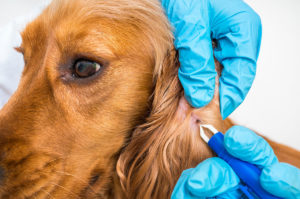
Be sure to speak with your veterinarian to determine the safest and best preventative for your furry friend and request any refills ahead of your trip if needed!
To learn more about parasites and parasitic diseases, check out these trusted resources:
American Veterinary Medical Association (AVMA)
Educational resources for pet owners about pet care and pet health
AVMA: Intestinal Parasites in Cats and Dogs Brochure
Centers for Disease Control and Prevention (CDC)
Parasites
Centers for Disease Control and Prevention (CDC)
Ticks
Companion Animal Parasite Council
TRAVEL ANXIETY & MOTION SICKNESS
In a perfect world, all dogs and cats would make great travel companions. Unfortunately, the world is an imperfect place, and some pets don’t travel well. Just like people, pets experience travel anxiety and even motion sickness.
TRAVEL ANXIETY
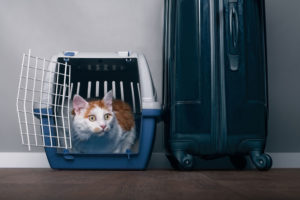
When it comes to travel, it’s safe to say that cats (as a species) don’t travel well. Even the sight of a crate or carrier can be enough to send some of our feline friends over the edge. Some owners find that their cats travel better in the cabin of an airplane than with them in a car. As with anything, there are exceptions. Our canine companions cannot be subjected to the same assumptions about travel anxiety. Dogs either have it or they don’t. For both species, intervention techniques using simple behavior modification and desensitization (if applied early) are the best strategy. This is a gradual process of acclimating your pet to the new environment using positive reinforcement. If done correctly, your pet will begin to desensitize and deactivate when presented with travel-related environmental triggers, and will learn to replace threats and negative travel associations with positive ones, making travel much more tolerable (even enjoyable!). Travel anxiety is similar to the stress reactions experienced during fireworks and thunderstorms. As you try different techniques to help reduce your pet’s stress when traveling, you may find that the same techniques can be applied to other areas as well. If your pet is starting to show less of a reaction to stress and anxiety triggers, that means you’re moving in the right direction!
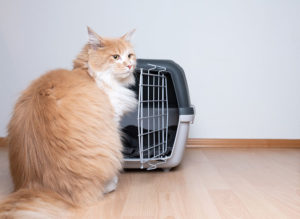
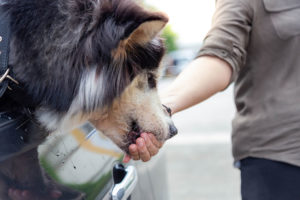
Not all pets respond to simple behavior modification and desensitization. Other suggestions include bringing in familiar toys and objects that your pet finds comforting. Some dogs and cats just need a distraction or something to keep them occupied. For dogs, try bringing some of your pup’s favorite chews or a Kong toy to snack on. For cats, try covering their carrier/crate with a blanket or towel. In other cases, using pheromone products such as Feliway® or Adaptil® or even a ThunderShirt® for your pet can be very helpful. Approved by your trusted veterinarians at Geary Veterinary Hospital, one product worth trying is ElleVet Sciences® Calm & Comfort Acute Strength CBD+CBDA Chews. Backed by scientific and medical research, a pilot study conducted at Cornell University College of Veterinary Medicine showed that 83% (20/24) of dogs had reduced stress or anxiety-related behaviors when given ElleVet Sciences® Calm & Comfort Acute Strength CBD+CBDA Chews two hours prior to the triggering event. Who can argue with that? If all else fails, there are prescription medications that your veterinarian can recommend to make traveling more tolerable for your pet.
Read the White Paper from ElleVet’s pilot study on ElleVet Sciences® Calm & Comfort Acute Strength CBD+CBDA Chews, by clicking here!
MOTION SICKNESS
Does your pet lick their lips, salivate and/or drool excessively, urinate/defecate, refuse food/water offers, or even vomit while traveling? Your pet may be experiencing motion sickness (in addition to underlying travel anxiety). Not to worry! Before talking to your veterinarian about medication, try having your pet travel on an empty stomach (no food for 4-6 hours prior to travel) to see if that helps. If your pet is still green in the gills, talk to your veterinarian about common, less effective OTC medications you can try to treat your pet’s motion sickness. A word of caution: although some OTC medications made for human use are considered safe for both cats and dogs (in the proper dosage), they may have adverse side effects in addition to making your pet drowsy. If you’re concerned about the possibility of your pet becoming drowsy from an OTC option, there is a more effective option available from your veterinarian that does not cause unmarked drowsiness. Talk to your veterinarian for more information, as it requires a prescription.
Talk to your veterinarian to determine which medications are best suited for your pet and how much to give!
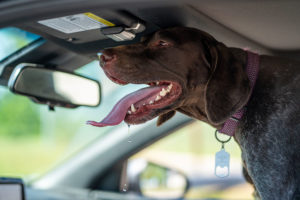
Photo by Gabe on Pexels
ROAD TRIP BEST PRACTICES

Photo by Patrick Hendry on Unsplash
PACKING ESSENTIALS
Collapsible Food/Water Bowls
Easy to clean, and easy store when not in use
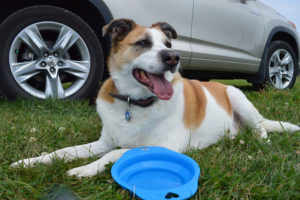
Photo by Doug Brown on Pexels
Emergency Medical Kit
Pre-made kits are available on Amazon, or make your own! Essential items to include: flashlight, small magnifying lens, alcohol wipes, triple antibiotic ointment, a muzzle, a slip lead leash, gauze, vet wrap, adhesive tape, hydrogen peroxide, tweezers, saline solution, chlorhexidine solution, bandages of various sizes, cast pads, ice pack, etc.
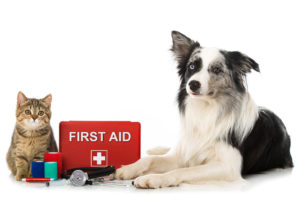
Food, Water, Toys, Bedding
Plenty of food, bottled water, treats, toys, pet bedding, and a pet carrier/crate (if needed for the car and/or wherever you may be spending the night)
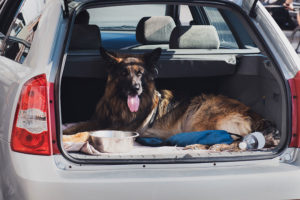
Medications
If your pet is prone to motion sickness and/or travel anxiety, bring all appropriate medications with you and administer them prior to departure. Skip your pet’s breakfast if he or she has a sensitive stomach.
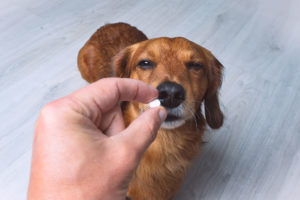
Waste Disposal and Cleaning Products
Plenty of poop bags, baby wipes, paper towels, sanitizing wipes, and trash bags
VEHICLE ESSENTIALS
Car Restraint
Make sure your pet is properly restrained in the backseat or cargo area of your vehicle. It’s never safe to have pets in the passenger seat due to possible airbag injury or death. A properly secured and anchored crate is the safest way for your pet to travel. If you prefer your pet to have a little more freedom, consider a seatbelt attachment for your pet’s harness (not their collar!), or a pet car seat.
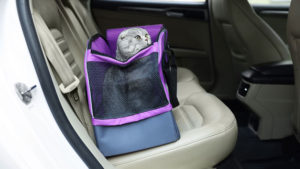
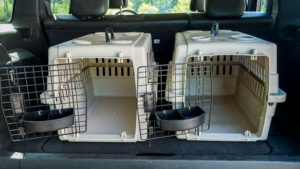
Never Leave Pets in Vehicles Unattended
Windows
Dangers of Automatic Windows
What pet doesn’t enjoy sticking its head out the backseat window? They’re living their best life; enjoying the present moment, after all! It may seem like fun and games, but a pet with its head out the window can be extremely dangerous, even deadly. An unrestrained dog in the back seat can accidentally roll down the power window and fall out of a moving vehicle, be injured by objects outside the moving vehicle, and be injured by the power windows themselves.
It’s better to be safe than sorry. Have the driver either close the windows completely or leave them open just enough to keep your pet comfortable and safe. Practice safe habits by restraining your pet in the car (whether the windows are locked or not) and making sure your pet has access to air and ventilation (bring a portable fan if necessary).
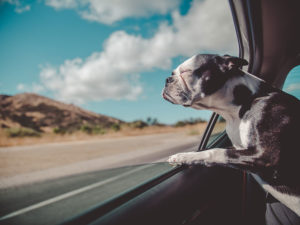
Photo by Avi Richards on Unsplash
Tinted Window Shades
Make sure your pet doesn’t overheat from the sun shining through your rear windows. Tinted windows for your car can protect your pup from overheating and help keep your car nice and cool.
PLANNING ESSENTIALS
Driving Limitations and Pet-friendly Accomodations

Know your limits and be realistic about how far you can safely travel in a day. Remember that your pet needs rest, too. If you’re not sure, start by setting a lower benchmark (miles or hours traveled) that you know you can easily reach. Evaluate how you (and your pet) are doing at various intervals and when you finally reach your benchmark. Re-evaluate each day and adjust your benchmark accordingly.
Once you have an idea of how far you can (safely) travel in a given day, find out which cities are near your benchmark and look for pet-friendly accommodations that have availability. Have a contingency plan just in case. If you’re not traveling in an RV/camper, plan your overnight stays in areas with multiple (pet-friendly) options. The more options the better, as some places may not allow your pet to stay without a crate.
There’s nothing worse than being stuck in a remote area, too tired to continue driving, with no plan and nowhere to go.

If your pet doesn’t travel or sleep in a crate or carrier, provide a comfortable bedding alternative for your pet. If you can easily transport your pet’s bedding (or crate) from your car to your overnight stay, great! If not, have something comfortable for your pet to use.
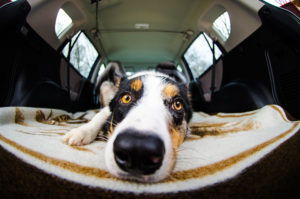
Photo by Brixiv on Pexels
If you’re worried about your pet making a mess or even having an accident while staying overnight somewhere, come prepared with the cleaning essentials: a crate, cleaning supplies, paper towels, urine spray, trash bags, spot cleaner, etc. Always take responsibility and accountability for your pet’s actions and behavior. If your pet makes a mess, be respectful and do your best to clean it up. Be honest and open with employees about incidentals as needed.

Pit-Stops
By planning your pit stops ahead of time, your pup can stretch his or her legs and get some exercise! BringFido is a great site that lists recreation spots, dog parks, dog-friendly restaurants, places to stay, dog-friendly rest stops, and more!
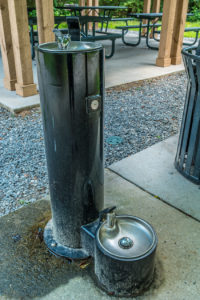
Urgent Care Facilities
In case your pet needs urgent care, have the names, numbers and locations of emergency veterinary clinics along your selected routes.
AIR TRAVEL BEST PRACTICES
If traveling with your pet means flying, be prepared! There’s a lot of planning, forethought, and preparation that needs to be done ahead of time to ensure a smooth trip. Below, we’ve outlined a few of the best practices to follow when traveling by air with your pet.
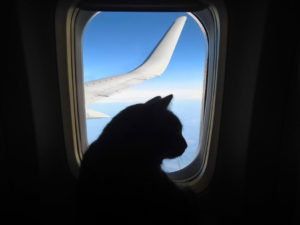
TRAVEL ARRANGEMENTS & AIRLINE REQUIREMENTS
The following information applies to all pets traveling by air, whether under the aircraft or in the cabin.
Secure Travel Arrangements - Early
Reservations for pets on flights are limited and are generally made on a first-come, first-served basis.
Fulfill Airline Requirements
Make sure your pet carrier requirements meet standard regulations and airline requirements.

Complete all necessary requirements and accommodations required by your airline well in advance of your departure. If a health certificate is required, call and schedule an appointment with your veterinarian as soon as possible (even if your airline requires your pet to be vet-checked 10-15 days prior to departure, call and set up that appointment in advance). Complete any requirements your veterinarian may have for you to be prepared for your appointment. Update necessary vaccinations, refill prescriptions and discuss any medications your pet may need for a smooth flight. If your pet is prescribed a new medication, test the medication on your pet prior to travel and make any necessary adjustments.
PRIOR TO TAKE-OFF
Check the Temperatures for Take-off and Landing
If your pet will be flying under the airplane – the airline may not allow your pet to fly if the temperature is too high or too low for your pet to tolerate.

Pet Relief Areas
Map out all of the “pet relief areas” both inside and outside of the airport (and all of the destination airports) ahead of time.
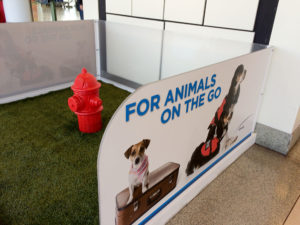
DAY-OF DEPARTURE
Allow Plenty of Time
When traveling with your pet, give yourself more time than you think you need. If your pet will be traveling under the airplane, be aware that airlines (in most cases) require your pet to be there even earlier. Check with your specific airline to confirm your pet’s time to arrive at the airport.

Photo by Angelina Litvin on Unsplash
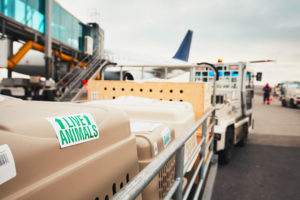
Exercise Before Travel
Make sure your pet gets as much exercise as possible before you head to the airport!

Photo by Isaac Davis on Unsplash
Make Sure Your Pet is Comfortable
Place your pet’s favorite toy (including a safe chew toy!), a comfort item or two, and soft bedding in his or her kennel. If your pet will be traveling underneath the plane, we recommend that you place a potty pad in his or her crate as well. You’ll be glad you did.
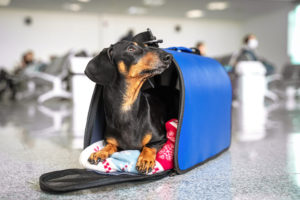
WHAT TO DO IF YOUR PET CAN’T COME WITH YOU
As much as we love to travel with our pets, there are times when it’s best to leave Fido at home (and that’s okay). Don’t worry, there are plenty of options for taking care of Fido while you’re away. Below are just some of the many pet care options available:

ALWAYS USE CAUTION AND READ REVIEWS CAREFULLY when considering any pet care service (individual or business)
Check entry requirements when researching a local care service for your pet (certain vaccinations may be required and must be current prior to entry).
BOARDING/KENNEL FACILITY
(Your) Veterinary Hospital/Practice
Check with your veterinary hospital/practice to see if they have boarding/kennel accommodations.
Please note that we do not offer boarding/kennel services at Geary Veterinary Hospital.
Local Boarding/Kennel Facilities
PET HOTEL
PET SITTER (INDEPENDENT)
An Individual You Know
Trusted friend, family member, neighbor, colleague, etc.
Trusted referrals and recommendations from people through local community groups in your area (if applicable).
*Nextdoor
Trusted and recommended referrals from people who live and work in your community.
Staff at (Your) Veterinary Hospital/Practice
Call your veterinarian’s office/practice and ask if there is someone on the staff who is available and willing to take care of Fido for a few extra dollars.
PET SITTER (SERVICES)
*East Bay Pet Services Association
*Fetch! Pet Care
*Vet Tech Pet Care
*Rover
*Wag!
*services are accessible via their website (click on the links to be taken there directly). Some of these services may offer a corresponding phone app for download.
ALWAYS USE CAUTION AND READ REVIEWS CAREFULLY when considering any pet care service (individual or business)
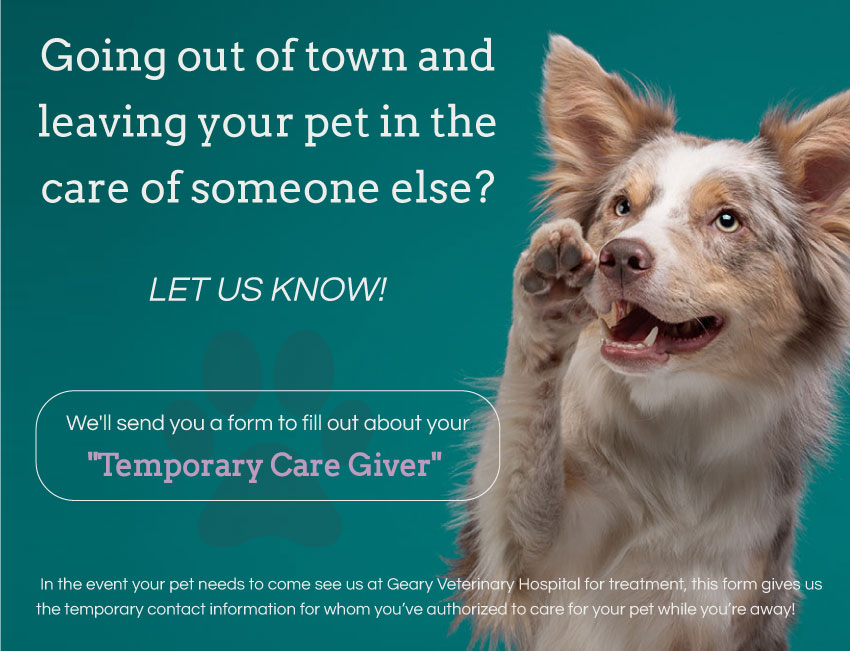
Other Summer Safety Tips
AVOID SIDEWALKS & ASPHALT
Hot sidewalks and pavement can injure unprotected paws. When the pavement reaches 125 degrees Fahrenheit, paw pads can burn in as little as one minute. Asphalt, in particular, can be 25-50 degrees hotter than the outside air temperature. As a general rule, you should avoid walking your dog (or cat) when surface temperatures are at their hottest (between 10 am and 7 pm). To get a sense of how hot it is, hold your hand on the ground for 5 seconds. If the pavement is too hot for you, it’s too hot for your pet. Having your pet wear protective footwear is an option worth considering when hot surfaces outside are unavoidable.
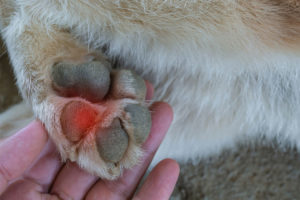

HEAT EXHAUSTION & HEAT STROKE
Check out our blog: Ten Signs Your Dog is Overheated and learn the signs of heat exhaustion and heat stroke. Both of these conditions are especially dangerous for dogs that are out and about in the summer months!
If you’re not sure if it’s too hot for your pet to be outside, you can check out the infographic below! Adapted from the Tufts Animal Care and Condition Weather Scale (TACC), this scale is a loose guideline that takes into account potential heat-related risk factors such as your pet’s size, age, body condition score, and more!
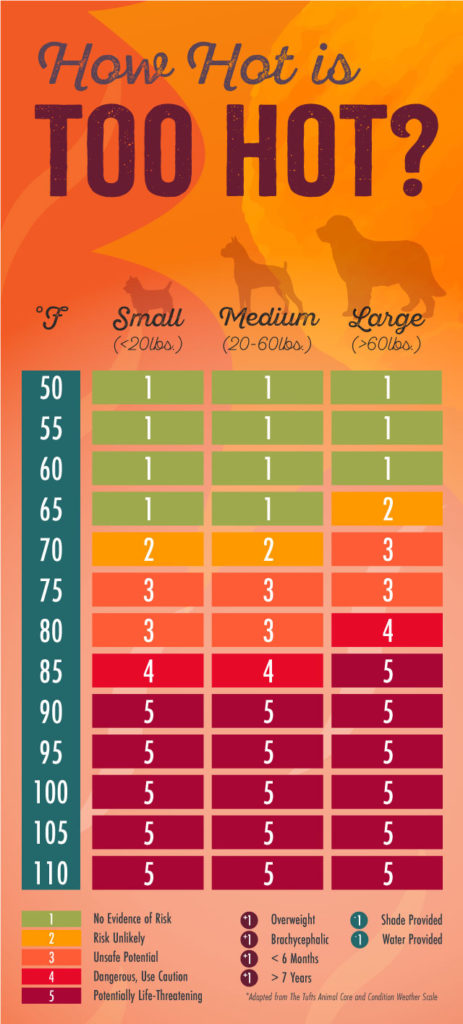
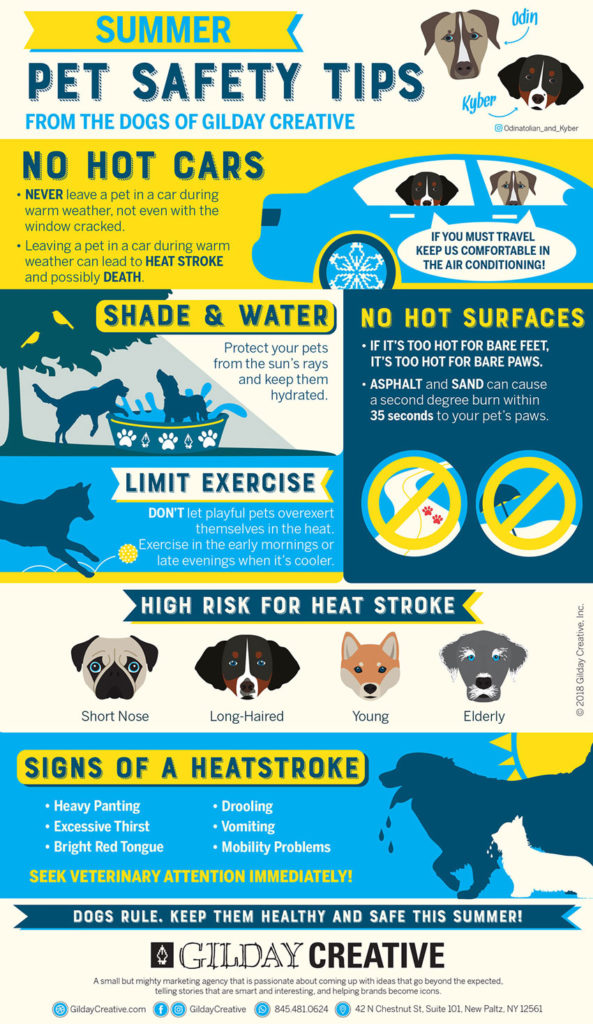
KEEP A CLOSE EYE ON YOUR PET (AT ALL TIMES)
If you can’t leave your pet at home for any reason, keep a close eye on your cat and keep your dog on a leash if you’re attending an event with fireworks or if you and your pet are caught in an unexpected storm. Keep your pet with you at all times.
If you’re away and your pet is home alone (especially during one of these events), it’s a good idea to invest in a home security camera that comes with a mobile app you can download to your phone for peace of mind. It may seem far-fetched (pun intended!), but if the power goes out during a heat wave and you don’t have a backup generator, your pet could be at risk of overheating. Checking in regularly with your phone could save your pet’s life, you never know!

NEVER LEAVE PETS IN PARKED CARS
NEVER leave your pet in a parked car, even if the temperature doesn’t seem that hot, and even if you’ve cracked a window. If the temperature outside is 72 degrees, the temperature inside a closed car can reach a deadly 116 degrees in less than an hour.
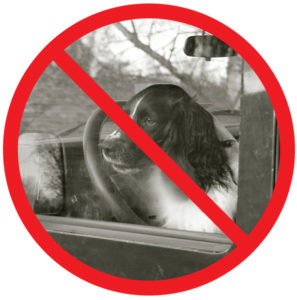
Photo by John on Pexels






Great page! What about walking temperatures on the pavement and blacktop? When is it “too hot” and how can I tell?
Hi Teresa!
Thanks for the wonderful comment! We recently added some additional content to the Summertime blog based on your feedback. You should see a chart that shows air temperature vs. asphalt temperature, in addition to an adaptation from The Tufts Animal Care and Condition Weather Scale! Hopefully these will help answer some of your questions! Let us know if you have any further questions! Thanks for reading and commenting! 🙂